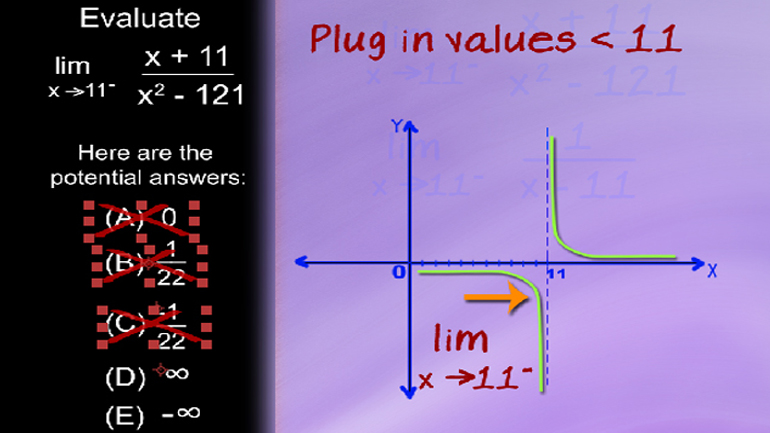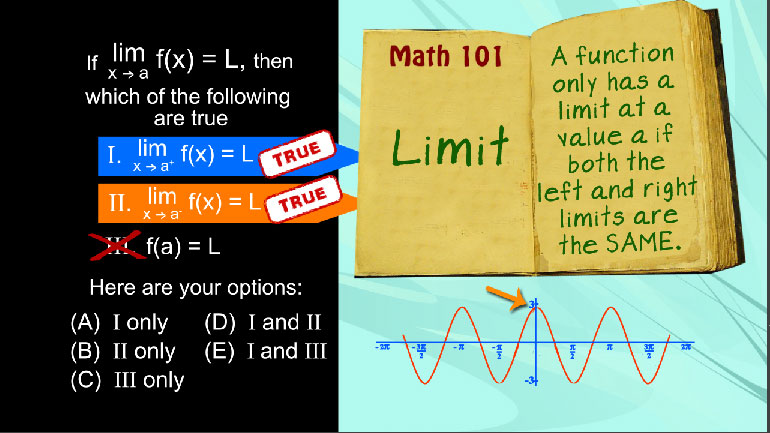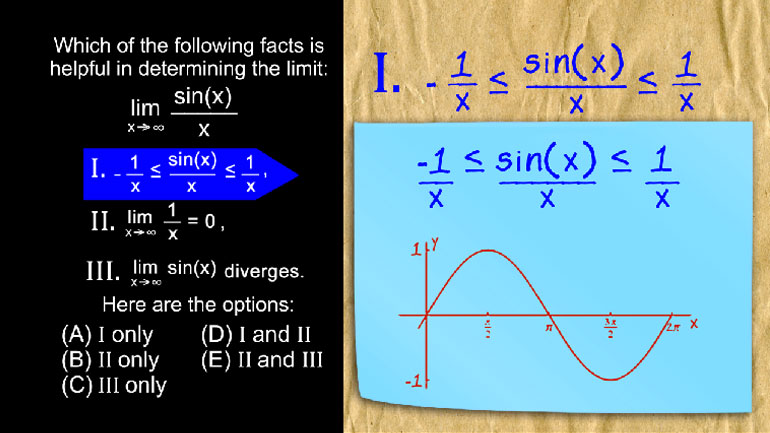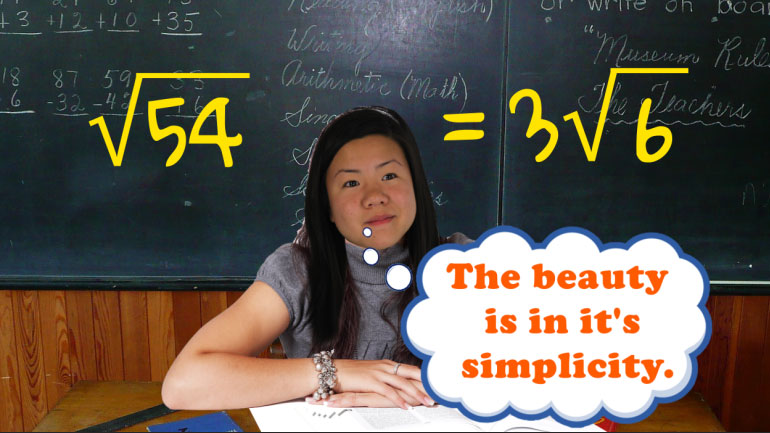ShmoopTube
Where Monty Python meets your 10th grade teacher.
Search Thousands of Shmoop Videos
Limits Videos 8 videos
AP Calculus: Problem Explanation Limits Drill 1, Problem 1. Which of the following are true about the pictured function?
AP Calculus: AB/BC Limits Drill 1, Problem 5. Evaluate the limit.
If you're working on developing a positive self-image, don't ever weigh yourself on planet Deneb-G73. Either the gravitational pull there is a tad...
Limits at Infinity 654 Views
Share It!
Description:
If you're working on developing a positive self-image, don't ever weigh yourself on planet Deneb-G73. Either the gravitational pull there is a tad wonky, or they really need to get their bathroom scales serviced.
Transcript
- 00:04
Limits at Infinity, a la Shmoop. Astronaut Buzz Goodyear and his crew have
- 00:11
encountered a foreign galaxy…
- 00:13
…and within that galaxy, a unique solar system.
- 00:16
Buzz has calculated equations to represent the gravitational patterns of every planet
- 00:21
in the system.
Full Transcript
- 00:23
Each equation has the format “H” equals f of “t”, where “H” is the height
- 00:28
in meters of the ball above the planet’s surface at any given time “t,”…
- 00:32
…where “t” is the number of seconds passed after the ball first hit the ground.
- 00:38
…that is, he’ll know how the function “H” behaves as “t” approaches infinity…
- 00:48
and beyond The first planet has a gravity equation of
- 00:51
“H” equals 2 “t”.
- 00:53
One second after the ball hits the ground, it’s at 2 feet…
- 00:57
…after five seconds the ball is at 10 feet…
- 00:59
…at a minute, it’s at 120 feet, and so on.
- 01:03
As more and more time passes, that is, as “t” approaches infinity…
- 01:07
…the ball will reach an infinite number of meters above the planet.
- 01:12
Therefore, in math terms, we can say that as “t” approaches infinity, “H” also
- 01:16
approaches infinity.
- 01:18
The general rule with functions like these is that if “t” is raised to a power greater
- 01:22
than zero…
- 01:23
…“H” will approach infinity; The second planet has an equation of “H”
- 01:27
equals 1 over “t.” We can rewrite this equation as t to the negative 1 power.
- 01:34
That means at one second after hitting the ground, the ball would be 1 meter off the
- 01:38
ground.
- 01:39
At five seconds, the ball would be a fifth of a meter off the ground.
- 01:43
As time passes and “t” approaches infinity, “H” gets smaller and smaller and really
- 01:48
really close to 0, but the ball will never actually touch the ground.
- 01:52
So as “t” approaches infinity, H approaches zero.
- 01:56
The general rule with functions like these is that if “t” is raised to a power less
- 02:00
than zero, “H” will approach zero. Now here are three planets in the same orbit,
- 02:06
each with completely different gravitational laws.
- 02:09
We can make general rules for limits that go to infinity based on the powers of the
- 02:13
leading terms of the numerator and denominator.
- 02:16
If the power of the numerator is less than the denominator, then as “t” approaches
- 02:21
infinity., “H” approaches zero .
- 02:23
This is true because the denominator increases faster than the numerator.
- 02:29
Let's test this. The first planet in this orbit has an equation of “H” equals “t”
- 02:33
over… “t” squared plus 1.
- 02:35
If we plug in t equals one, the numerator is one and the denominator is one squared
- 02:40
plus one, which is one plus one, or two.
- 02:45
At t equals ten, H equals ten over ten squared plus one, which is a hundred plus one, or
- 02:51
one hundred one.
- 02:52
If we continue plugging in bigger values for t, the fraction H gets smaller and smaller.
- 02:56
So, as t approaches infinity, H approaches zero, but never actually equals zero.
- 03:02
The second planet in the orbit has an equation of “H” equals 4 “t” squared over … “t”
- 03:08
squared plus 1.
- 03:09
Uh-oh. The powers of the numerator and denominator are the same, so we have to do something different.
- 03:16
Here, we can just take the coefficients and divide them by each other to get the limit.
- 03:21
We can take the leading coefficient of the numerator, four, and divide it by the leading
- 03:25
coefficient of the denominator, one…
- 03:27
…to get that the limit of H as t approaches infinity is four over one, or four.
- 03:34
Finally, the third planet in the orbit has an equation of “H” equals 2 “t” cubed
- 03:39
over… “t” squared plus 1.
- 03:42
Since we are taking the limit as t approaches infinity, we can just divide the leading terms
- 03:45
2 t cubed and t squared to get an accurate approximation of the limit.
- 03:51
We can ignore the plus one because everything besides the leading terms is negligible…
- 03:55
…since the leading terms determine the behavior of a polynomial at infinity.
- 04:00
2 t cubed divided by t squared equals two t.
- 04:03
We can plug in infinity for t to get 2 times infinity.
- 04:07
Infinity isn't really a number, so multiplying it by two just leaves it as infinity.
- 04:13
So, the limit of H as t approaches infinity is also infinity.
- 04:19
As a recap, the general rules for rational functions are:
- 04:24
If the power of the numerator is less than the denominator, then as “t” approaches
- 04:28
infinity., “H” approaches zero
- 04:33
If the power of the numerator and the denominator are the same, then as “t” approaches infinity…
- 04:38
…“H” approaches a constant; specifically, the number achieved when the leading coefficient
- 04:43
of the numerator is divided by that of the denominator.
- 04:46
And finally, if the power of the numerator is greater than the denominator…
- 04:51
…“H” approaches either negative or positive infinity as “t” approaches infinity…
- 04:56
…depending on the signs of the leading coefficients of the numerator and denominator.
- 05:02
There are many rules...but it’s vital to remember that infinity is not a real number,
- 05:05
but a concept, just like forever or eternity.
- 05:08
But if it helps, you can think of infinity as representing a really big, undefined number.
- 05:15
Seems like Buzz is going to have to take his crew elsewhere, though.
- 05:18
Preferably a galaxy where gravity isn’t so bonkers.
- 05:21
This isn’t how he wanted to lose weight.
Related Videos
Who wants to be a millionaire? In this video, learn about compound interest, interest rates, and the compound interest formula. You'll be buying th...
ACT Math: Pre-Algebra Drill 5, Problem 2. If a and b are prime numbers, how many factors does ab have?
We don't like knocking people down to size, but we do like simplifying radicals. Join us?
If fleeing criminals always fled the scene of the crime at perfect right angles, it would be much easier to determine their whereabouts. Fortunatel...












